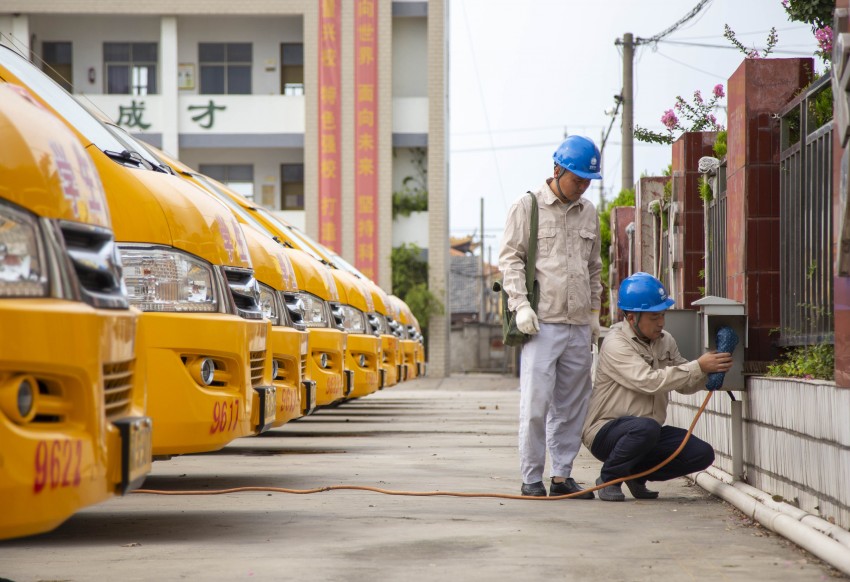
MERICS China Industries Briefing - October 2020
1. Fifth Plenum places innovation at the center of China’s modernization
At a glance: The Central Committee of the Chinese Communist Party (CCP) concluded four days of closed-door plenary meetings during which it discussed and adopted draft proposals for the formulation of the 14th Five-Year Plan (FYP) – China’s national blueprint for economic and social development from 2021 to 2025. The closing communiqué indicated twelve high-level policy priorities for the coming five years. These include:
-
Upholding the central role of innovation in China’s modernization drive
-
Accelerating the development of a modern industrial system including strategic emerging industries
-
Forming a strong domestic market and promoting the dual circulation strategy (双循环)
The communiqué also announced a series of “long-range objectives” for 2035. China is, for instance, to build a modernized economy with per capita GDP at the level of “moderately developed countries” within the next 15 years. Other objectives include significantly increasing China’s economic and technological strength, achieving major breakthroughs in core technologies, and becoming a globally leading nation in innovation.
MERICS comment: Given China’s persistent high-tech development and self-sufficiency drive, it comes as no surprise that innovation featured prominently on the CCP’s list of development priorities. However, it is the first time that a five-year plan will position science and technology independence and self-reliance (科技自立自强) as a “strategic pillar” for national development. This is a strong indicator that China’s tech and industrial policy will stay the course, even amid – or precisely because of – tensions with the US. The inclusion of other buzzwords in the high-level communiqué, such as China’s ambitions to become a manufacturing, cyber and transportation “superpower” with an advanced industrial base, further confirms that China’s leadership is going to continue pursuing its tech-driven industrial upgrading goals.
The communiqué itself did not specify technology areas that will receive priority treatment. The Central Committee’s formal proposal for the formulation of the 14th FYP - published only today – offers slightly more detail. Taken together with extensive signaling in the weeks leading up to the plenum, this indicates that key emerging technologies and ‘new infrastructure’ such as advanced semiconductors, new energy vehicles, 5G and artificial intelligence are slated for special policy support. Quantum technology was already announced as one of the new high-tech areas to feature in the 14th FYP following remarks by Xi Jinping highlighting its importance. It will be interesting to see whether the likely increase in policy support for China-made semiconductors will address concerns voiced recently by regulators about the excessive resource waste that has resulted from companies’ race to become China’s next chip champion.
Policy name: Communiqué of the Fifth Plenary Session of the 19th Central Committee of the CCP (中国共产党第十九届中央委员会第五次全体会议公报) (Link)
Issuing body: CCP Central Committee
Date: October 29, 2020
The plenum communiqué published by the Central Committee only provides a high-level overview of the initial cornerstone priorities of the 14th FYP. More details were announced in the slightly more detailed planning document published on November 3, titled the “Proposals for the Formulation of the 14th Five-Year Plan (2021-2025) for National Economic and Social Development and the Long-Range Objectives Through the Year 2035” (关于制定国民经济和社会发展第十四个五年规划和二〇三五年远景目标的建议). However, the complete 14th FYP document with numerical targets and policy details is only set to be publicly released after its formal approval by the National People’s Congress in March 2021. Subsequently, local governments and individual ministries will issue their own regional-, sector- and issue-specific FYPs, which contain action plans for policy implementation. One particularly interesting plan to watch will be the FYP for national science and tech innovation. The Ministry of Science and Technology (MOST) has recently called for research contributions on major issues that should inform the plan. This suggests that additional policy support for domestic innovation is in the cards.
2. Chinese legislators approve national laws with foreign implications
At a glance: China’s top legislative body, the National People’s Congress Standing Committee (NPCSC), reviewed and approved a series of significant national laws during a session held from October 13 to 17. Some of the most noteworthy outcomes of the meeting include:
- Passage of the Export Control Law (出口管制法), China’s first unified framework for export controls – taking effect on December 1, 2020
- Approval of the fourth revision of the Patent Law (专利法), which increases punishments for patent violations – taking effect on June 1, 2021
- Publication of a first draft of the Personal Information Protection Law (个人信息保护法) – open to public comments until November 19, 2020
MERICS comment: The laws have significant ramifications for Europe. Vague wording in both the Export Control Law and the draft Personal Information Protection Law open the door to sweeping retaliation measures against foreign companies and countries. The former cites harm done to China’s “national security and interests,” while the latter cites “discriminatory” measures taken against China concerning personal data as examples of legislative violations that warrant retaliation. On a more practical level, European firms with extensive operations in China, especially in R&D, will likely face additional compliance hurdles. These could include novel license requirements and security review procedures related to exporting goods, technologies and services, as well as collecting, processing and transferring personal information.
The revision of the Patent Law, on the other hand, promises to be a welcome development for European companies, which have long faced patent infringement issues in China. It raises the mandated pay compensation for patent violations to up to CNY 5 million (ca. EUR 630,000) and establishes an early resolution mechanism for pharmaceutical patent disputes. The law is another sign that Beijing may finally be getting serious about IP rights issues – not least because protecting IP rights is a crucial prerequisite for translating R&D breakthroughs into marketable solutions and thus enabling China’s innovation-driven development.
3. Shenzhen receives more autonomy to spearhead open development
At a glance: The Central Committee of the CCP and the State Council issued a plan for pilot reforms in Shenzhen. The plan advances the implementation of the pioneering pilot area for “socialism with Chinese characteristics” - first announced in August last year - and sets out goals for 2020, 2022 and 2025. It proposes a series of measures to promote, for instance:
- Greater market access in sectors such as energy, telecoms and transportation
- Fewer restrictions on foreign investment in cutting-edge technologies
- Systematic attraction of international top-talents
- Introduction of a data trading market
- Support for Shenzhen to pioneer in the digitalization and internationalization of the Chinese Yuan
The plan works towards achieving greater market-orientation in a more open, rules-based and innovation-friendly business environment (think: better IPR protection). Ticking one of the 2020 goals off the list, the National Development and Reform Commission (NDRC) has already announced the first 40 focus areas for reforms, including simplifying business registrations in particularly innovative industries and setting up a fund to promote mixed ownerships in the civil aviation industry. Details on how exactly to proceed with the touted reforms, however, are missing.
MERICS comment: The implementation plan grants more authority to local cadres in the hope of reviving the experimental spirit that drove China’s economic miracle in the early 1980s. Shenzhen has been pushed as China’s reform pioneer for several decades. It represents the country’s flagship model of rapid industrial development – from a manufacturing center to a high-tech hub with international allure. The release of the document coincides with the 40th anniversary celebration of the Shenzhen Special Economic Zone (SEZ), as part of which President Xi Jinping embarked on a three-day southern tour. Xi lauded Shenzhen’s success story and, once more, stressed the importance of self-dependent innovation.
Xi’s trip and remarks also lend stronger support to the development of a unified Greater Bay Area – spanning Guangdong, Shenzhen, Hong Kong and Macau. However, it remains to be seen whether the renewed focus on Shenzhen will translate into a back seat for other economic pivots in the region such as Hong Kong. It is also questionable whether the reform efforts will satisfy foreign actors. Irrespective of any reformist intentions envisioning a greater role for market forces, the new plan corroborates the overarching party-state control over China’s economy. It thus threatens to suffocate the creative leeway that the Chinese leadership initially granted Shenzhen and that formed the basis of the SEZ’s strength.
Policy name: Implementation Plan (2020-2025) for the Establishment of a Pilot Demonstration Zone for Socialism with Chinese Characteristics in Shenzhen as a Comprehensive Reform Pilot (深圳建设中国特色社会主义先行示范区综合改革试点实施方案(2020-2025年)) (Link)
Issuing bodies: CCP Central Committee, State Council
Date: October 11, 2020
4. Beijing embarks on a new phase of new energy vehicle developments
At a glance: On October 9, the State Council executive meeting passed a major development plan for the upcoming 15 years of China’s new energy vehicle (NEV) industry. It is a revision of last year’s draft that pushes for an increase of NEV market shares as part of China’s green industrial upgrade. The updated plan has not yet been released. However, the meeting hinted at two major adaptations:
- Public funds will be pumped into the construction of charging stations, with a special (and new) focus on fast-charging ones
- Starting next year, NEVs should make up for at least 80 percent of newly added or upgraded public vehicles in National Ecological Civilization Pilot Zones (国家生态文明试验区) and Focus Areas for Air Pollution Prevention and Control (大气污染防治重点区域) – a notable reduction from the previous goal of 100 percent
There are no indications so far that the ambitious goals of having NEVs and intelligent-connected vehicles (ICVs) account for 25 percent and 30 percent of new vehicle sales by 2025, respectively, as stated in the draft have changed. The same goes for the pledge of greater support for fuel cell vehicles, focusing on R&D in hydrogen production, storage and transportation.
MERICS comment: It was high time for the adoption of the NEV Development Plan. A rapid yet quality-focused expansion of the industry will be crucial for China to reach the ambitious goal of carbon neutrality by 2060 and reduce its dependence on fossil fuel imports. The new plan highlights the importance of hydrogen – a technology that was barely mentioned in the previous NEV plan for 2012-2020 – and is in line with Beijing’s recent measures in support of the domestic fuel cell industry.
However, such innovative NEV developments have not yet taken off. Though China says it wants to “lead the transformation of the global automobile industry,” it still has weaknesses in NEV core technologies and sluggish infrastructure construction. Li Yizhong, former minister of the Ministry of Industry and Information Technology (MIIT), pointed out that China needs to formulate a proper hydrogen strategy to keep up with international developments and realize “green hydrogen” (绿色氢能). The “Energy-Saving and NEV Technology Roadmap 2.0” released on October 27 envisions greater autonomy and leadership in core technologies and an even more aspiring 50 percent market share for NEV sales by 2035. Given that NEVs accounted for less than 5 percent of car sales in 2019, however, it seems unlikely that China will reach its ambitious market share goals.
Policy name: New Energy Vehicle Industry Development Plan (2021-2035) (新能源汽车产业发展规划(2021-2035年)(征求意见稿)) (Link)
Issuing body: MIIT
Date: December 3, 2019 – passed by State Council on October 9, 2020
Worth noting
Policy news
- October 13: MOST announces 11 new National High-Tech Industrialization Bases, including an AI base in Beijing and a new materials base in Pingdingshan (MOST notice (CN))
- October 14: MIIT and the Ministry of Emergency Management release a three-year action plan on “Industrial Internet + Safe Production” (MIIT release (CN))
- October 15: MEE and NDRC release a notice on the improvement of green production monitoring and auditing in key industries such as energy, metallurgy and building materials (MEE notice (CN))
- October 19: MIIT calls for applications by November 20 for pilot demonstration projects in manufacturing-Internet integrated development for 2020, listing Sino-German smart manufacturing cooperation as a separate focus category (MIIT notice (CN))
- October 21: NDRC vows to strengthen supervision of the semiconductor industry to tackle over-investment and wasting of resources (NDRC comments (CN); Caixin (EN))
- October 23: NDRC and five other ministries issue opinions on supporting private enterprises in accelerating reforms and upgrading, highlighting the aim to further ease market access (NDRC opinions (CN); Xinhua article (EN))
- October 24: MOT presents opinions and sets goals through to 2049 for modernizing the national transportation governance system (MOT notice (CN))
Corporate news
- October 10: State-owned oil giant Sinopec Group plans to invest in hydrogen energy, using a fund it had set up in August (Caixin article (EN))
- October 13: Audi signs MoU with long-term partner Chinese state-owned FAW Group on jointly producing NEVs for the Chinese market, starting in 2024 (Automotive News Europe article (EN); Electrive article (DE))
- October 14: Chinese smartphone-maker Oppo announces deal with Deutsche Telekom to sell its 5G smartphones in Germany, Poland and the Netherlands (Nikkei Asia article (EN); Reuters article (EN))
- October 14: Apple presents its new 5G-enabled iPhone 12 in Beijing, which is compatible with China’s BeiDou navigation system (Caixin article (EN))
- October 19: Tesla starts exporting China-made Model 3 to more than 10 European countries in October (SCMP article (EN))
- October 20: Sweden bans Huawei and ZTE from 5G telecoms network, causing China to threaten the prospects of Swedish companies operating in China (Financial Times article (EN); SCMP article (EN))
The MERICS China Industries Briefing is a monthly round-up of key developments in China’s industrial policy landscape and innovation system. It features brief analyses of the government’s industrial strategies, technology plans and policy guidelines that shape China’s industrial upgrading and economic trajectory. The briefing also captures corporate activities that are driving cooperation and competition between Chinese entities and their European counterparts.
If you would like to receive the MERICS China Industries Briefing in your mailbox, subscribe here.




